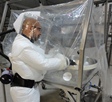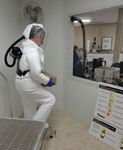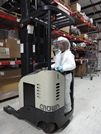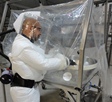
PAPRs: Primary or Secondary Protection Options
Several advances are in operational use. They improve the safety of operations and improve user comfort for increased productivity.
- By Alan E. George
- Nov 01, 2012
The use of Powered Air Purifying Respirators (PAPRs) is a valuable tool for the environmental health & safety aspects of a pharmaceutical manufacturing operation when working to protect personnel around highly hazardous or potent compounds. There is significant evidence pointing to the benefits of PAPRs as a primary source of protection, as well as when they are used in conjunction with containment controls at the point of emission.
Use of PAPRs as the primary source for protection of personnel in areas where containment is not a feasible option exists today and will continue to be needed in the future. Applications of this include processing equipment that is difficult to contain (a fluid bed processor where the bowl needs to be removed but containment can not be implemented, for example), during cleaning of the processing equipment, cleaning of the containment control device after processing, or when cleaning the entire processing suite itself.
Combining a PAPR with a process that can be contained using alternative particulate containment solutions (i.e., an engineered control) brings significant safety benefits. In this combined approach, protection to nanogram levels can be realized with the primary containment controlling the powder emission at the source and the PAPR providing added protection levels due to the already lower concentration of potent product in the processing suite.
Use of Applied Protection Factor Testing
Data from an Applied Protection Factor (APF) test supports the claims of any specific PAPR design as a means of protecting personnel in hazardous environments.
OSHA Standard 29 CFR 1910.134 (d)(3)(i)(A) states the following relative to Assigned Protection Factors for Powered Air Purifying Helmets or Hoods:
"The employer must have evidence provided by the respirator manufacturer that testing of these respirators demonstrates performance at a level of protection of 1,000 or greater to receive an APF of 1,000. This level of performance can best be demonstrated by performing a WPF or SWPF study or equivalent testing. Absent such testing, all other PAPRs and SARs with helmets/hoods are to be treated as loose-fitting facepiece respirators, and receive an APF of 25."
Simulated Workplace Protection Factor studies (SWPF) are required for the PAPR manufacturer to state an APF of 1,000, the highest protection factor that may be claimed per the OSHA requirements. Testing conducted using an SWPF protocol provides verification of the published safety levels by using a series of exercises, performed within a chamber containing a challenge such as a corn oil aerosol, which simulates the various operations one may encounter in the workplace.
 Figure 1. This photo shows an example of simulated work exercises.
Figure 1. This photo shows an example of simulated work exercises.
The study also quantifies fit factor performance using a panel of subjects with facial sizes derived using the Los Alamos National Laboratory (LANL) evaluation criteria currently in use by NIOSH for respirator certification. This test is performed to ensure a respirator will protect as expected while maintaining proper fit across the broad range of 5th percentile female to 95th percentile male.
Ergonomic and Design Details Are Key Factors in PAPR Selection
The design of PAPRs continues to evolve. Voice of the Customer (VOC) input is a critical factor in supporting the improving the design of these systems. Historically, such comments have been expressed as user discomfort from prolonged wear of a hood with a headband, loss of visibility when a hood is not secured adequately, having to touch a filter element to change out the filter after it has been contaminated, separate batteries and battery cables being snagged, issues with the decon-ability of belts, and NiCad batteries losing memory over time.
Systems on the market today are moving to integrated batteries to replace tethered designs, filter elements where the media is encased in a cartridge, non-slip belts and back harnesses that move the weight off of the user’s waist, decon-able materials for these belts and back harnesses, and panoramic hoods that secure at the operator’s coveralls. These advances are in operational use. They improve the safety of operations, as when operating a forklift as shown in figure 2, and improve user comfort for increased productivity.
 Figure 2. Panoramic hood design supports a wide field of view, including upward visibility.
Figure 2. Panoramic hood design supports a wide field of view, including upward visibility.
Combined Technologies Drive Protection Levels Even Lower
One analogy that has been used in industry presentations references the use of part of a grain of sugar in a fixed volume. To demonstrate what a containment level of 1 µg/m3 would be like, the subject matter expert giving the presentation asked the audience to visualize taking a grain of sugar that is 3 milligrams in size, cutting that one grain into three pieces, dividing one of those three pieces of sugar into 1,000 parts, and then placing one of those 1,000 particles in a box that is 1meter by 1meter by 1meter in size. He then offered that this would be the equivalent of containing a process to 1 µg/m3.
There are applications today where even lower protection levels are being achieved by combining containment with the use of PAPRs. As an example, one Contract Manufacturing Organization (CMO) that is handling highly potent compounds has established a combination of highly specialized facilities and controls as a part of its processing operating procedures. As part of the overall corporate safety program, this organization has chosen to integrate flexible containment solutions and PAPRs in its day-to-day operations. Wet granulation, dry granulation, oven drying, fluid bed drying, milling, blending, encapsulation, tableting, and de-dusting are all examples of manufacturing processes in which this CMO has integrated containment and respiratory protection technologies.
 Figure 3. This is an example of the combined use of respiratory protective equipment and a flexible enclosure as a containment device.
Figure 3. This is an example of the combined use of respiratory protective equipment and a flexible enclosure as a containment device.
Whether as a stand-alone respiratory protection system or as secondary protection when combined with a proven engineering control, PAPRs continue to support highly hazardous manufacturing operations in dedicated and multi-purpose facilities.
This article originally appeared in the November 2012 issue of Occupational Health & Safety.